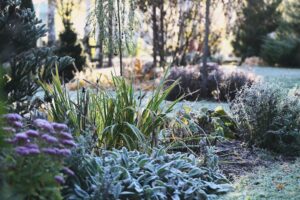Many people feel that a south-facing aspect offers the ideal position for a garden, but there are pros and cons! Our team offer some top tips for gardening in south-facing conditions.
What is a south-facing garden?
A south-facing garden is exactly what it sounds like – it’s a garden that faces south! To find out if your garden is facing south, simply step outside with your back to your house and get a trusty compass out. If the compass is pointing south, then you have a south-facing garden!
Benefits of a south-facing garden
If you are a sun worshipper, a south-facing garden will give you maximum hours of direct sunlight compared with other garden aspects – with a potential for up to 16 hours in the height of the summer. The benefit of outdoor living in the warmer months means you can consider an outside dining area, BBQ, pizza oven or even an outdoor kitchen. You can also embrace plants which enjoy warm, dry conditions and even throw some tropical varieties into the mix!

Disadvantages of a south-facing garden
A hot and sunny garden can mean that you need to water your lawn and plants much more regularly, and you may struggle with soil moisture levels even in the spring and autumn. The sunlight can also be overwhelming for delicate plants in south-facing beds and you may find the need to create some shadier spots.
How to prepare soil for a south-facing garden
Soils in south-facing gardens tend to become arid. You’re likely to benefit from some good compost, soil conditioner and topsoil that gives any plants you choose the maximum amount of nutrients whilst helping to retain as much moisture as possible.
Mulching will also be essential with a south-facing aspect and spreading a thick layer of peat-free material twice yearly, in spring and winter, will help retain moisture, suppress weeds and regulate the soil temperature.

Best plants for a south-facing garden
Gardening in a south-facing space needs some thought and it’s worth spending the time thinking about what to plant where in your space. Some sun-loving plants will thrive in bright and sunny conditions whereas others prefer a bit more shade.
· Mediterranean herbs will flourish in a bright garden and offer your kitchen some flavour in exchange for very little work. Plant in pots or a free-draining border and the scent of rosemary, thyme, and oregano will fill the summer days. The flowers from these plants will also attract pollinators.
· Geraniums are another plant that adores being left alone in a sunny spot. Annuals such as Sunflowers, Zinnias, and Marigolds will also thrive.
· Alliums are one of the most striking plants in the garden and can be planted as bulbs for summer flowering.
· Evergreen plants that love a sunny outlook include Pittosporum and Helianthemum or Rock Roses.
· If you have a very sheltered spot, you could even think tropical in a south-facing garden, growing banana plants, bamboo (ensure this is not an invasive species) and palms. These may need to be wrapped up and protected during a hard winter but could make your summer spectacular!
· Certain vegetables will also love being gown in the sunniest of spots – think chillis, tomatoes, peppers and cucumbers. You could even try a melon or have grape vines!

Create shade for plants
Some plants don’t enjoy being exposed to sunlight so think carefully about the placement of these. Is there a shadier spot or can you create one under a tree? Trees are an excellent addition to any garden and even a small plot can contain one. One mature tree is said to be the equivalent of two air conditioning units in your garden and the canopy can introduce some welcome respite from the sun.
You may also like to add an area with a sunscreen or pergola with climbing plants to introduce some further shade. Plants that enjoy these shadier conditions include Ferns and Hostas. Azaleas also benefit from a shadier patch as they can become scorched in full sun.
Lawn care for a south-facing garden
A lawn will love facing south and will contain less moss – which can suffocate the grass itself. It’s likely to need watering if you want things to remain lush and green in the hot summer months. Don’t worry too much; grass is resilient and will bounce back with the first autumn rains.
East-facing garden
If you have an east-facing garden, we’ve put together a handy blog on the best plants for east-facing gardens.
Products for your south-facing garden
Whichever way your garden faces, getting the basics right will increase your chances of successful growing and our peat-free products are the best place to start.
We offer free delivery across the UK. Order bulk bags of topsoil, bulk bags of compost or today for curbside delivery.




